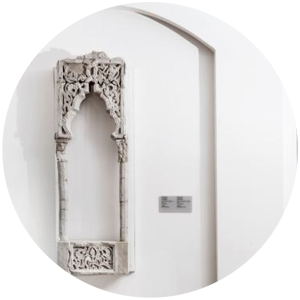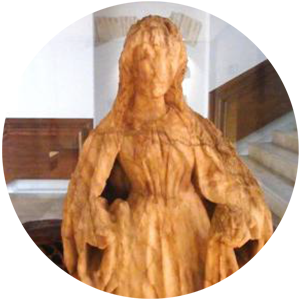This room belongs to the Gothic-Mudejar palace from the 14th century. In that time, the Pope Juan XXII raised the bishopric to archbishopric, concretely in 14th June 1318, making bishoprics of Jaca, Huesca, Tarazona, Pamplona, Albarracín and Calahorra would dependant on archbishopric of Zaragoza. From that moment, archbishops started leading the coronation of the Kings of Aragon in La Seo of Zaragoza, the bishop’s see. First archbishop of was Pedro López de Luna.
Rooms in this floor introduce us into the palace of the Kings of Aragon rooms, allowing us to see remains from different periods in which this palace served as residence for prelate and for royal family when they visited Zaragoza.
This room belongs to the Gothic-Mudejar palace from the 14th century. In that time, the Pope Juan XXII raised the bishopric to archbishopric, concretely in 14th June 1318, making bishoprics of Jaca, Huesca, Tarazona, Pamplona, Albarracín and Calahorra would dependant on archbishopric of Zaragoza. From that moment, archbishops started leading the coronation of the Kings of Aragon in La Seo of Zaragoza, the bishop’s see. First archbishop of was Pedro López de Luna.
Rooms in this floor introduce us into the palace of the Kings of Aragon rooms, allowing us to see remains from different periods in which this palace served as residence for prelate and for royal family when they visited Zaragoza.

![]()
This fragment belongs to a Gothic-Mudejar window made by carved plaster from the palace extension ordered by King Peter IV “the Ceremonious” and archbishop Lope Fernández de Luna, after the fire that took place in 1372. In origin this window was polychrome as we can appreciate remains of red pigment in the vegetal decoration on surface.

This fragment belongs to a Gothic-Mudejar window made by carved plaster from the palace extension ordered by King Peter IV “the Ceremonious” and archbishop Lope Fernández de Luna, after the fire that took place in 1372. In origin this window was polychrome as we can appreciate remains of red pigment in the vegetal decoration on surface.

![]()
The sculpture of Saint Mary Magdalene decorated the entrance of the church of Santa María Magdalena, in Zaragoza. Its style shows the influence of Flemish art in the Aragonese art of the XV century. Beyond this glass window, we see the staircase built 18th century during the palace extension towards south. This extension was initiated by enlightened Archbishop Benardo Velarde y Velarde, also known as “Father of the Poor”. He decided to begin a series of architectonical works to generate employment in a moment in which poverty reigned in society. This staircase is the access to the archbishop’s palace reception zone from 16th century.

The sculpture of Saint Mary Magdalene decorated the entrance of the church of Santa María Magdalena, in Zaragoza. Its style shows the influence of Flemish art in the Aragonese art of the XV century. Beyond this glass window, we see the staircase built 18th century during the palace extension towards south. This extension was initiated by enlightened Archbishop Benardo Velarde y Velarde, also known as “Father of the Poor”. He decided to begin a series of architectonical works to generate employment in a moment in which poverty reigned in society. This staircase is the access to the archbishop’s palace reception zone from 16th century.
Did you know?…
- In this zone of the palace, some kings and Popes lived here such as King Charles III of Navarre in 1406, Pope Benedict XIII in 1410, Pope Adrian VI in 1522 and King Philip II of Spain.
- Princess Isobel of Castile died in this palace in 1498 when giving birth to Prince Miguel de la Paz. If this infant had survived, he would have become king of Castile, Aragon and Portugal.
Did you know?…
- In this zone of the palace, some kings and Popes lived here such as King Charles III of Navarre in 1406, Pope Benedict XIII in 1410, Pope Adrian VI in 1522 and King Philip II of Spain.
- Princess Isobel of Castile died in this palace in 1498 when giving birth to Prince Miguel de la Paz. If this infant had survived, he would have become king of Castile, Aragon and Portugal.
